EN120 Assignment: English Composition I - Sentence Errors & Plagiarism
VerifiedAdded on 2023/06/10
|6
|1253
|304
Homework Assignment
AI Summary
This assignment for English Composition I (EN120) includes two parts: sentence correction and an essay on plagiarism. The sentence correction section requires selecting the appropriate words to complete sentences. The essay defines plagiarism, discusses its negative effects (ranging from academic penalties to legal repercussions), and outlines two methods for avoiding it: proper citation and conducting thorough research to generate original ideas. Proper citation involves acknowledging sources using established styles like APA or Harvard, while brainstorming and research encourage the development of fresh perspectives and conclusions, ensuring the work is original and avoids plagiarism. Desklib provides this solution and other resources for students.
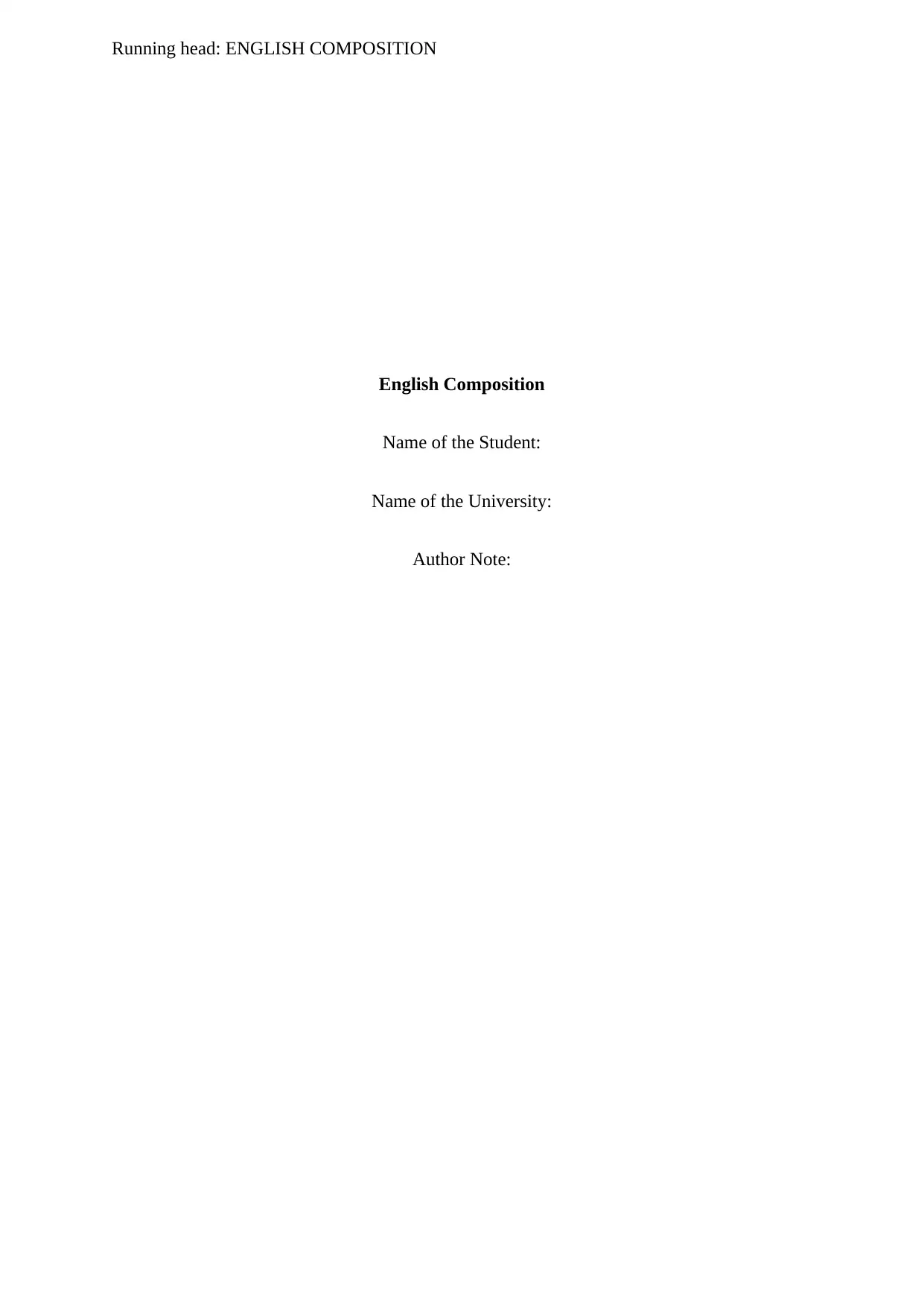
Running head: ENGLISH COMPOSITION
English Composition
Name of the Student:
Name of the University:
Author Note:
English Composition
Name of the Student:
Name of the University:
Author Note:
Paraphrase This Document
Need a fresh take? Get an instant paraphrase of this document with our AI Paraphraser
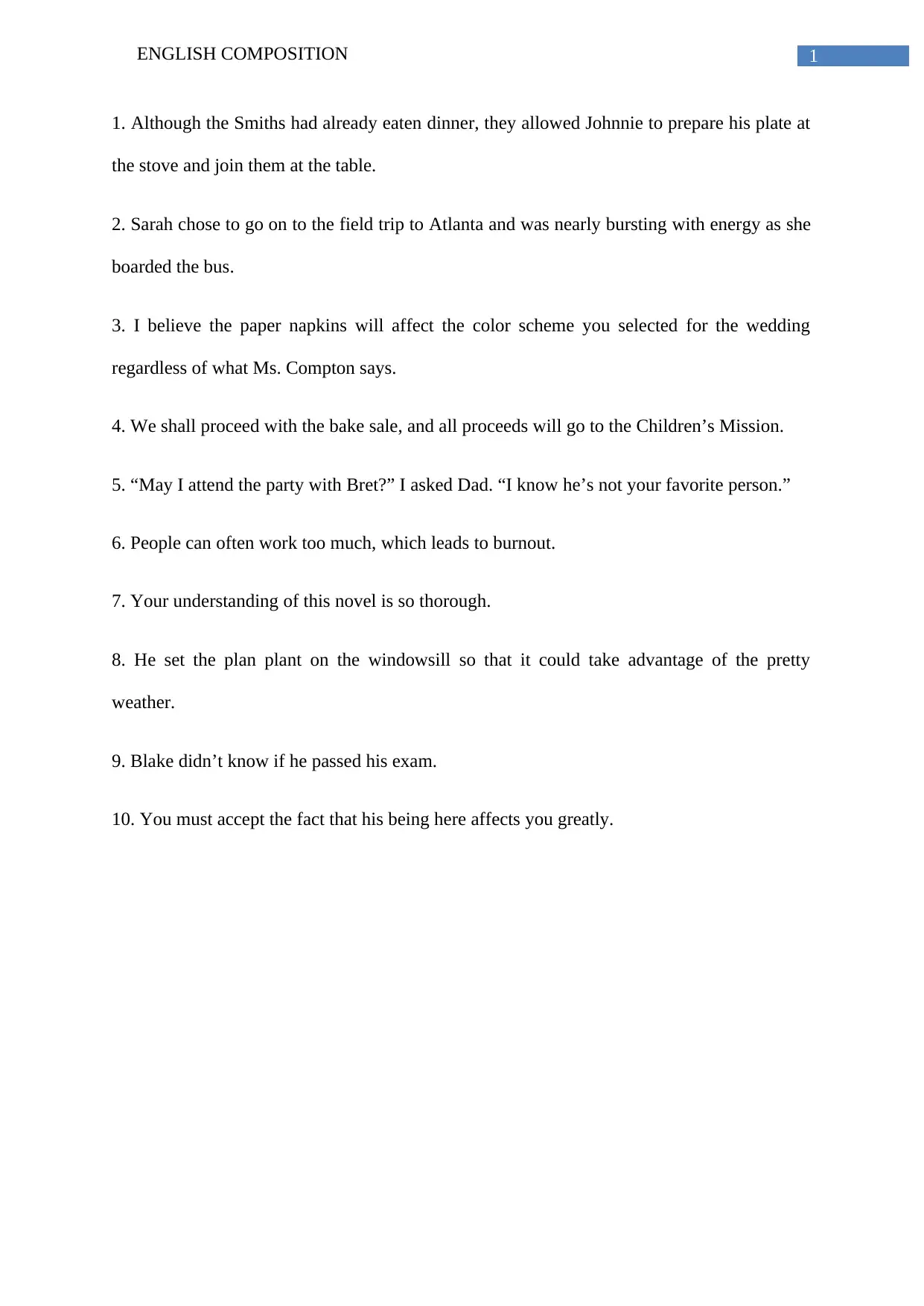
1ENGLISH COMPOSITION
1. Although the Smiths had already eaten dinner, they allowed Johnnie to prepare his plate at
the stove and join them at the table.
2. Sarah chose to go on to the field trip to Atlanta and was nearly bursting with energy as she
boarded the bus.
3. I believe the paper napkins will affect the color scheme you selected for the wedding
regardless of what Ms. Compton says.
4. We shall proceed with the bake sale, and all proceeds will go to the Children’s Mission.
5. “May I attend the party with Bret?” I asked Dad. “I know he’s not your favorite person.”
6. People can often work too much, which leads to burnout.
7. Your understanding of this novel is so thorough.
8. He set the plan plant on the windowsill so that it could take advantage of the pretty
weather.
9. Blake didn’t know if he passed his exam.
10. You must accept the fact that his being here affects you greatly.
1. Although the Smiths had already eaten dinner, they allowed Johnnie to prepare his plate at
the stove and join them at the table.
2. Sarah chose to go on to the field trip to Atlanta and was nearly bursting with energy as she
boarded the bus.
3. I believe the paper napkins will affect the color scheme you selected for the wedding
regardless of what Ms. Compton says.
4. We shall proceed with the bake sale, and all proceeds will go to the Children’s Mission.
5. “May I attend the party with Bret?” I asked Dad. “I know he’s not your favorite person.”
6. People can often work too much, which leads to burnout.
7. Your understanding of this novel is so thorough.
8. He set the plan plant on the windowsill so that it could take advantage of the pretty
weather.
9. Blake didn’t know if he passed his exam.
10. You must accept the fact that his being here affects you greatly.
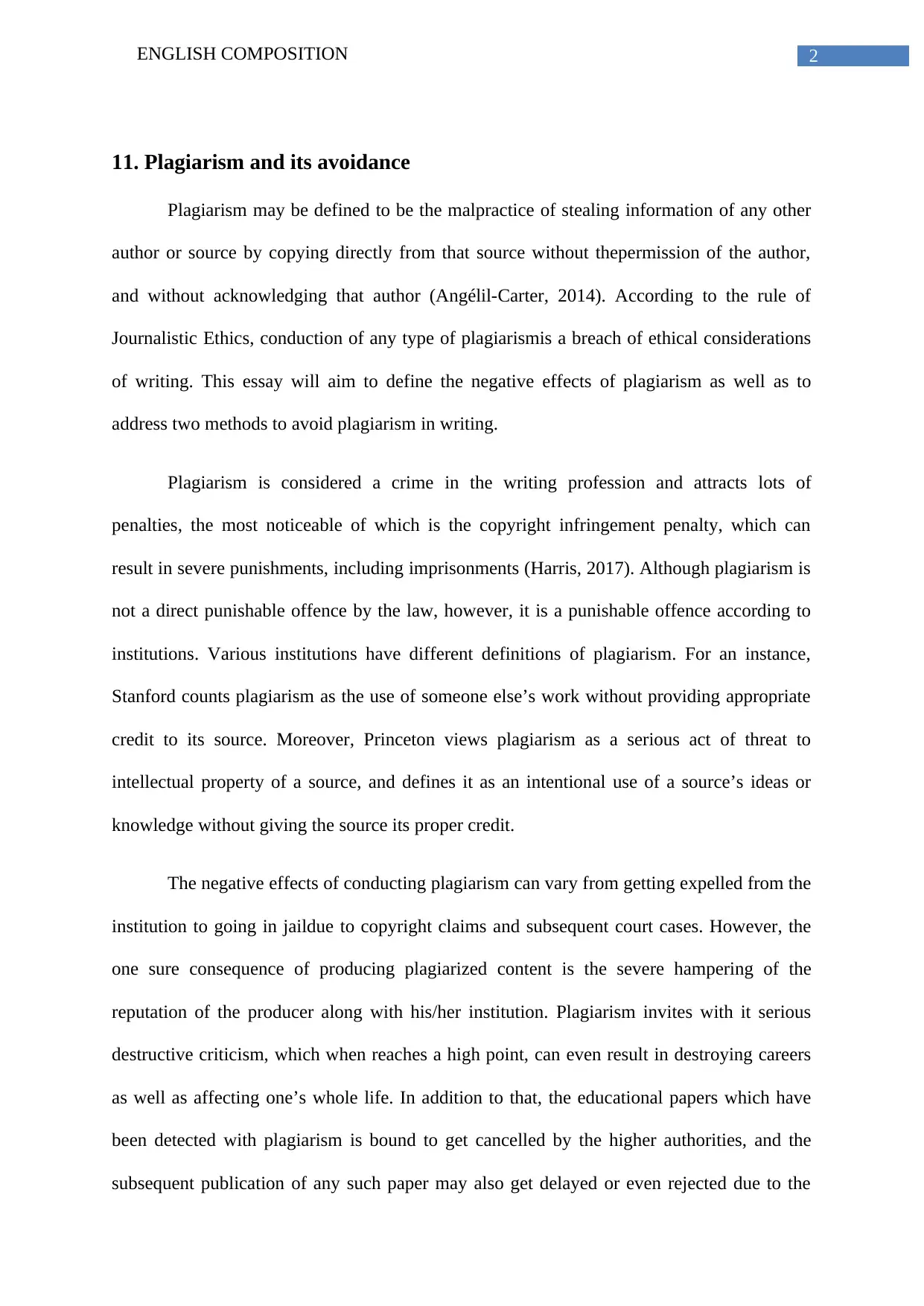
2ENGLISH COMPOSITION
11. Plagiarism and its avoidance
Plagiarism may be defined to be the malpractice of stealing information of any other
author or source by copying directly from that source without thepermission of the author,
and without acknowledging that author (Angélil-Carter, 2014). According to the rule of
Journalistic Ethics, conduction of any type of plagiarismis a breach of ethical considerations
of writing. This essay will aim to define the negative effects of plagiarism as well as to
address two methods to avoid plagiarism in writing.
Plagiarism is considered a crime in the writing profession and attracts lots of
penalties, the most noticeable of which is the copyright infringement penalty, which can
result in severe punishments, including imprisonments (Harris, 2017). Although plagiarism is
not a direct punishable offence by the law, however, it is a punishable offence according to
institutions. Various institutions have different definitions of plagiarism. For an instance,
Stanford counts plagiarism as the use of someone else’s work without providing appropriate
credit to its source. Moreover, Princeton views plagiarism as a serious act of threat to
intellectual property of a source, and defines it as an intentional use of a source’s ideas or
knowledge without giving the source its proper credit.
The negative effects of conducting plagiarism can vary from getting expelled from the
institution to going in jaildue to copyright claims and subsequent court cases. However, the
one sure consequence of producing plagiarized content is the severe hampering of the
reputation of the producer along with his/her institution. Plagiarism invites with it serious
destructive criticism, which when reaches a high point, can even result in destroying careers
as well as affecting one’s whole life. In addition to that, the educational papers which have
been detected with plagiarism is bound to get cancelled by the higher authorities, and the
subsequent publication of any such paper may also get delayed or even rejected due to the
11. Plagiarism and its avoidance
Plagiarism may be defined to be the malpractice of stealing information of any other
author or source by copying directly from that source without thepermission of the author,
and without acknowledging that author (Angélil-Carter, 2014). According to the rule of
Journalistic Ethics, conduction of any type of plagiarismis a breach of ethical considerations
of writing. This essay will aim to define the negative effects of plagiarism as well as to
address two methods to avoid plagiarism in writing.
Plagiarism is considered a crime in the writing profession and attracts lots of
penalties, the most noticeable of which is the copyright infringement penalty, which can
result in severe punishments, including imprisonments (Harris, 2017). Although plagiarism is
not a direct punishable offence by the law, however, it is a punishable offence according to
institutions. Various institutions have different definitions of plagiarism. For an instance,
Stanford counts plagiarism as the use of someone else’s work without providing appropriate
credit to its source. Moreover, Princeton views plagiarism as a serious act of threat to
intellectual property of a source, and defines it as an intentional use of a source’s ideas or
knowledge without giving the source its proper credit.
The negative effects of conducting plagiarism can vary from getting expelled from the
institution to going in jaildue to copyright claims and subsequent court cases. However, the
one sure consequence of producing plagiarized content is the severe hampering of the
reputation of the producer along with his/her institution. Plagiarism invites with it serious
destructive criticism, which when reaches a high point, can even result in destroying careers
as well as affecting one’s whole life. In addition to that, the educational papers which have
been detected with plagiarism is bound to get cancelled by the higher authorities, and the
subsequent publication of any such paper may also get delayed or even rejected due to the
⊘ This is a preview!⊘
Do you want full access?
Subscribe today to unlock all pages.

Trusted by 1+ million students worldwide
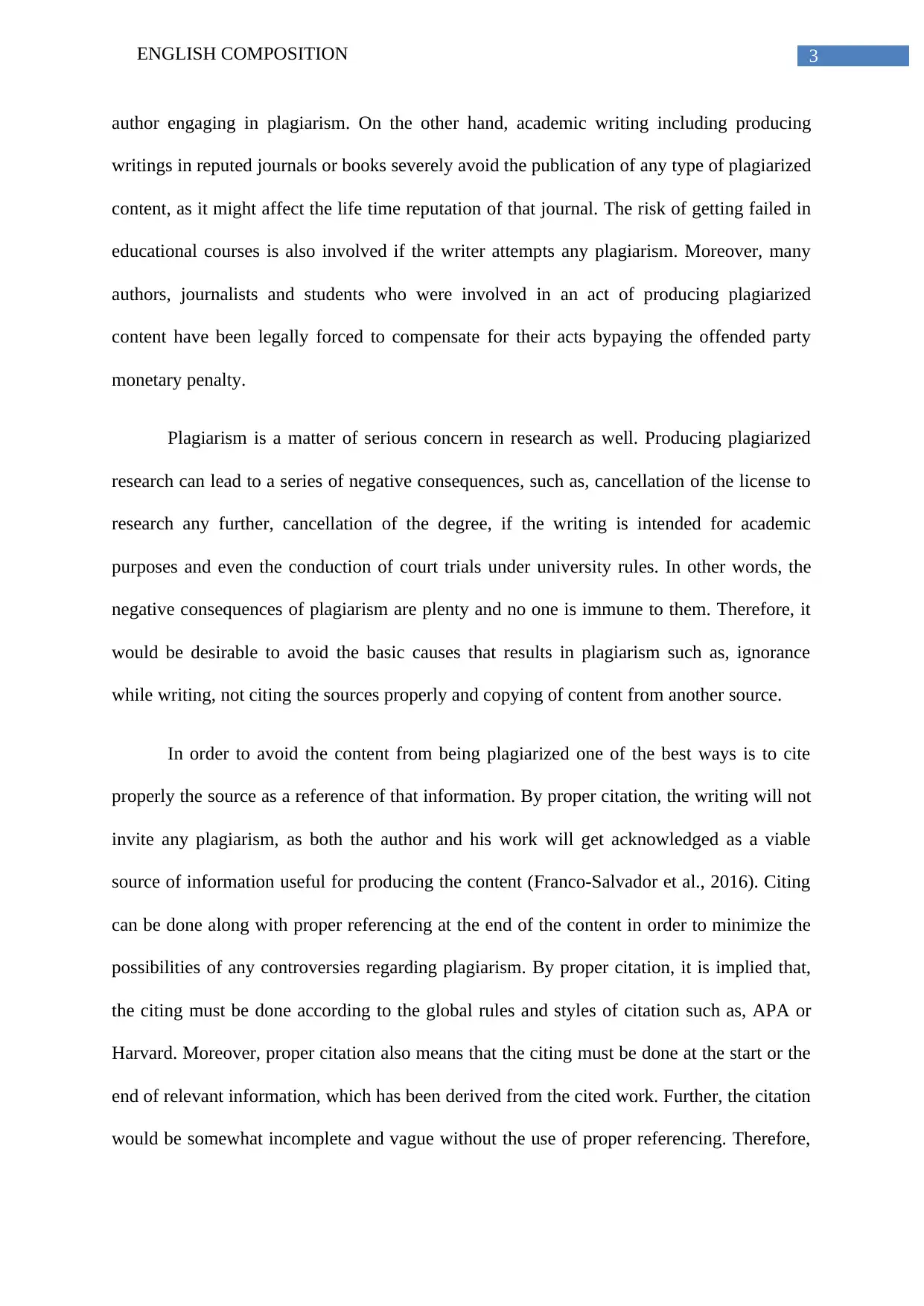
3ENGLISH COMPOSITION
author engaging in plagiarism. On the other hand, academic writing including producing
writings in reputed journals or books severely avoid the publication of any type of plagiarized
content, as it might affect the life time reputation of that journal. The risk of getting failed in
educational courses is also involved if the writer attempts any plagiarism. Moreover, many
authors, journalists and students who were involved in an act of producing plagiarized
content have been legally forced to compensate for their acts bypaying the offended party
monetary penalty.
Plagiarism is a matter of serious concern in research as well. Producing plagiarized
research can lead to a series of negative consequences, such as, cancellation of the license to
research any further, cancellation of the degree, if the writing is intended for academic
purposes and even the conduction of court trials under university rules. In other words, the
negative consequences of plagiarism are plenty and no one is immune to them. Therefore, it
would be desirable to avoid the basic causes that results in plagiarism such as, ignorance
while writing, not citing the sources properly and copying of content from another source.
In order to avoid the content from being plagiarized one of the best ways is to cite
properly the source as a reference of that information. By proper citation, the writing will not
invite any plagiarism, as both the author and his work will get acknowledged as a viable
source of information useful for producing the content (Franco-Salvador et al., 2016). Citing
can be done along with proper referencing at the end of the content in order to minimize the
possibilities of any controversies regarding plagiarism. By proper citation, it is implied that,
the citing must be done according to the global rules and styles of citation such as, APA or
Harvard. Moreover, proper citation also means that the citing must be done at the start or the
end of relevant information, which has been derived from the cited work. Further, the citation
would be somewhat incomplete and vague without the use of proper referencing. Therefore,
author engaging in plagiarism. On the other hand, academic writing including producing
writings in reputed journals or books severely avoid the publication of any type of plagiarized
content, as it might affect the life time reputation of that journal. The risk of getting failed in
educational courses is also involved if the writer attempts any plagiarism. Moreover, many
authors, journalists and students who were involved in an act of producing plagiarized
content have been legally forced to compensate for their acts bypaying the offended party
monetary penalty.
Plagiarism is a matter of serious concern in research as well. Producing plagiarized
research can lead to a series of negative consequences, such as, cancellation of the license to
research any further, cancellation of the degree, if the writing is intended for academic
purposes and even the conduction of court trials under university rules. In other words, the
negative consequences of plagiarism are plenty and no one is immune to them. Therefore, it
would be desirable to avoid the basic causes that results in plagiarism such as, ignorance
while writing, not citing the sources properly and copying of content from another source.
In order to avoid the content from being plagiarized one of the best ways is to cite
properly the source as a reference of that information. By proper citation, the writing will not
invite any plagiarism, as both the author and his work will get acknowledged as a viable
source of information useful for producing the content (Franco-Salvador et al., 2016). Citing
can be done along with proper referencing at the end of the content in order to minimize the
possibilities of any controversies regarding plagiarism. By proper citation, it is implied that,
the citing must be done according to the global rules and styles of citation such as, APA or
Harvard. Moreover, proper citation also means that the citing must be done at the start or the
end of relevant information, which has been derived from the cited work. Further, the citation
would be somewhat incomplete and vague without the use of proper referencing. Therefore,
Paraphrase This Document
Need a fresh take? Get an instant paraphrase of this document with our AI Paraphraser
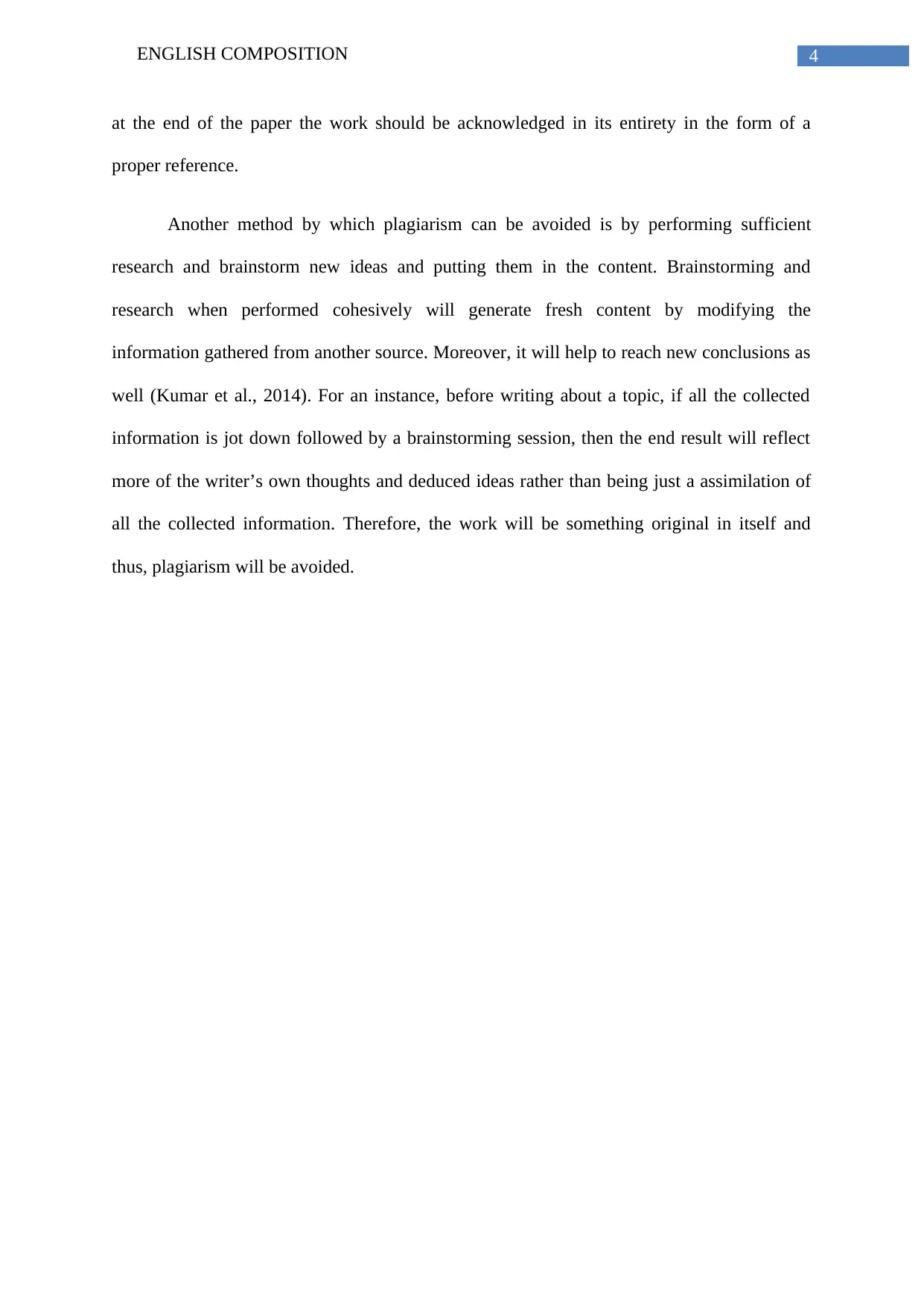
4ENGLISH COMPOSITION
at the end of the paper the work should be acknowledged in its entirety in the form of a
proper reference.
Another method by which plagiarism can be avoided is by performing sufficient
research and brainstorm new ideas and putting them in the content. Brainstorming and
research when performed cohesively will generate fresh content by modifying the
information gathered from another source. Moreover, it will help to reach new conclusions as
well (Kumar et al., 2014). For an instance, before writing about a topic, if all the collected
information is jot down followed by a brainstorming session, then the end result will reflect
more of the writer’s own thoughts and deduced ideas rather than being just a assimilation of
all the collected information. Therefore, the work will be something original in itself and
thus, plagiarism will be avoided.
at the end of the paper the work should be acknowledged in its entirety in the form of a
proper reference.
Another method by which plagiarism can be avoided is by performing sufficient
research and brainstorm new ideas and putting them in the content. Brainstorming and
research when performed cohesively will generate fresh content by modifying the
information gathered from another source. Moreover, it will help to reach new conclusions as
well (Kumar et al., 2014). For an instance, before writing about a topic, if all the collected
information is jot down followed by a brainstorming session, then the end result will reflect
more of the writer’s own thoughts and deduced ideas rather than being just a assimilation of
all the collected information. Therefore, the work will be something original in itself and
thus, plagiarism will be avoided.
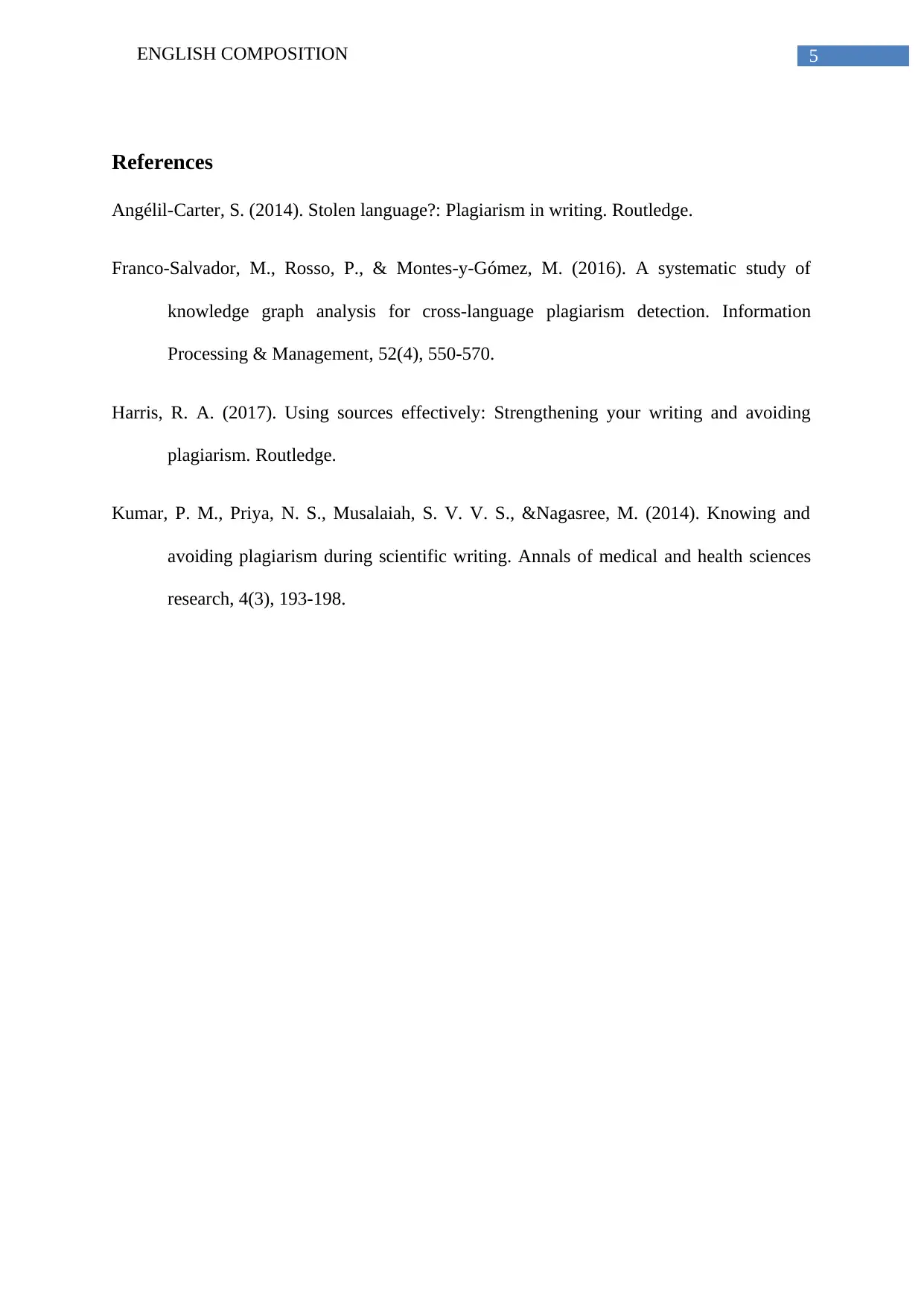
5ENGLISH COMPOSITION
References
Angélil-Carter, S. (2014). Stolen language?: Plagiarism in writing. Routledge.
Franco-Salvador, M., Rosso, P., & Montes-y-Gómez, M. (2016). A systematic study of
knowledge graph analysis for cross-language plagiarism detection. Information
Processing & Management, 52(4), 550-570.
Harris, R. A. (2017). Using sources effectively: Strengthening your writing and avoiding
plagiarism. Routledge.
Kumar, P. M., Priya, N. S., Musalaiah, S. V. V. S., &Nagasree, M. (2014). Knowing and
avoiding plagiarism during scientific writing. Annals of medical and health sciences
research, 4(3), 193-198.
References
Angélil-Carter, S. (2014). Stolen language?: Plagiarism in writing. Routledge.
Franco-Salvador, M., Rosso, P., & Montes-y-Gómez, M. (2016). A systematic study of
knowledge graph analysis for cross-language plagiarism detection. Information
Processing & Management, 52(4), 550-570.
Harris, R. A. (2017). Using sources effectively: Strengthening your writing and avoiding
plagiarism. Routledge.
Kumar, P. M., Priya, N. S., Musalaiah, S. V. V. S., &Nagasree, M. (2014). Knowing and
avoiding plagiarism during scientific writing. Annals of medical and health sciences
research, 4(3), 193-198.
⊘ This is a preview!⊘
Do you want full access?
Subscribe today to unlock all pages.

Trusted by 1+ million students worldwide
1 out of 6
Related Documents
Your All-in-One AI-Powered Toolkit for Academic Success.
+13062052269
info@desklib.com
Available 24*7 on WhatsApp / Email
![[object Object]](/_next/static/media/star-bottom.7253800d.svg)
Unlock your academic potential
Copyright © 2020–2025 A2Z Services. All Rights Reserved. Developed and managed by ZUCOL.





